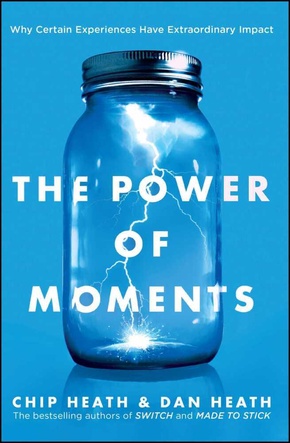The Power of Moments - Why Certain Moments Have Extraordinary Impact
| Verlag | Simon & Schuster US |
| Auflage | 2017 |
| Seiten | 320 |
| Format | 14,4 x 21,8 x 2,2 cm |
| Gewicht | 300 g |
| Artikeltyp | Englisches Buch |
| ISBN-10 | 1501179489 |
| EAN | 9781501179488 |
| Bestell-Nr | 50117948UA |
The New York Times bestselling authors of Switch and Made to Stick explore why certain brief experiences can jolt us and elevate us and change us-and how we can learn to create such extraordinary moments in our life and work.
While human lives are endlessly variable, our most memorable positive moments are dominated by four elements: elevation, insight, pride, and connection. If we embrace these elements, we can conjure more moments that matter. What if a teacher could design a lesson that he knew his students would remember twenty years later? What if a manager knew how to create an experience that would delight customers? What if you had a better sense of how to create memories that matter for your children?
This book delves into some fascinating mysteries of experience: Why we tend to remember the best or worst moment of an experience, as well as the last moment, and forget the rest. Why "we feel most comfortable when things are certain, but we feel most alive when they\'re not." And why our most cherished memories are clustered into a brief period during our youth.
Readers discover how brief experiences can change lives, such as the experiment in which two strangers meet in a room, and forty-five minutes later, they leave as best friends. (What happens in that time?) Or the tale of the world\'s youngest female billionaire, who credits her resilience to something her father asked the family at the dinner table. (What was that simple question?)
Many of the defining moments in our lives are the result of accident or luck-but why would we leave our most meaningful, memorable moments to chance when we can create them? The Power of Moments shows us how to be the author of richer experiences.
Leseprobe:
The Power of Moments 1 Defining Moments
1.
Chris Barbic and Donald Kamentz were sitting at a pub in Houston, recuperating from another 14-hour day running their start-up charter school. They were drinking beer. Watching ESPN. And sharing a Tombstone pizza, the bar\'s only food offering. They had no idea, on that night in October 2000, that they were moments away from an epiphany that would affect thousands of lives.
ESPN was previewing the upcoming National Signing Day, the first day when graduating high school football players can sign a binding "letter of intent" to attend a particular college. For college football fans, it\'s a big day.
Watching the exuberant coverage, something struck Kamentz. "It blows my mind that we celebrate athletics this way, but we don\'t have anything that celebrates academics in the same way," he said. And the students at their school-primarily kids from low-income Hispanic families-deserved celebrating. Many of them would be the first in their families to graduate from high school.
Barbic had founded a school to serve those students. He\'d grown disillusioned teaching sixth grade at a local elementary school. "I saw way too many of my students head off to the local junior high excited about school and eager to pursue their dreams, only to return a few months later with that light in their eyes totally gone." They would come back to visit him, telling stories of gangs, drugs, pregnancies. It crushed him. He knew he had two choices: Quit teaching to spare himself. Or build the school that those students deserved. So in 1998, Barbic founded YES Prep. And Donald Kamentz was one of the first people he hired.
In the pub that night, as they watched the Signing Day preview, they had a sudden inspiration: What if we created our own "Signing Day," when our students would announce where they will attend college? The event would allow them to honor all graduating seniors, since it was a condition of graduation at YES Prep that every student apply and be accepted to college, even if they ultimately chose not to attend.
Their excitement grew as they shaped the idea: They would call it Senior Signing Day, and for that one day, graduating seniors would be treated with the same hype and adulation as college athletes.
About six months later, on April 30, 2001, they held the first Senior Signing Day. Roughly 450 people crammed into a community center next door to their campus: 17 graduating seniors and their families, along with every other student in the YES Prep system-from juniors to sixth graders.
Each of the seniors took the stage, announcing where he or she would be attending college in the fall: "My name is Eddie Zapata, and in the fall, I will be attending Vanderbilt University!" They would unveil a T-shirt or pennant with their chosen school\'s insignia. Many of the students kept their final school decision a secret from friends, so there was suspense in the air. After each announcement, the room erupted with cheers.
Later, the students would sit at a table, with their families crowded around them, and sign letters of matriculation, confirming their enrollment in the fall. Barbic was struck by the emotion of the "signing" moment: "It hits home-the sacrifices that everybody had to make for their kids to get there. No one did it alone. There were lots of people involved." By the end of the ceremony, there were few dry eyes in the room.
Senior Signing Day became the most important annual event for the YES Prep school network. For seniors, the event was a celebration, the capstone of their achievement. But it held a different kind of meaning for younger students. At the third Senior Signing Day, which had expanded

